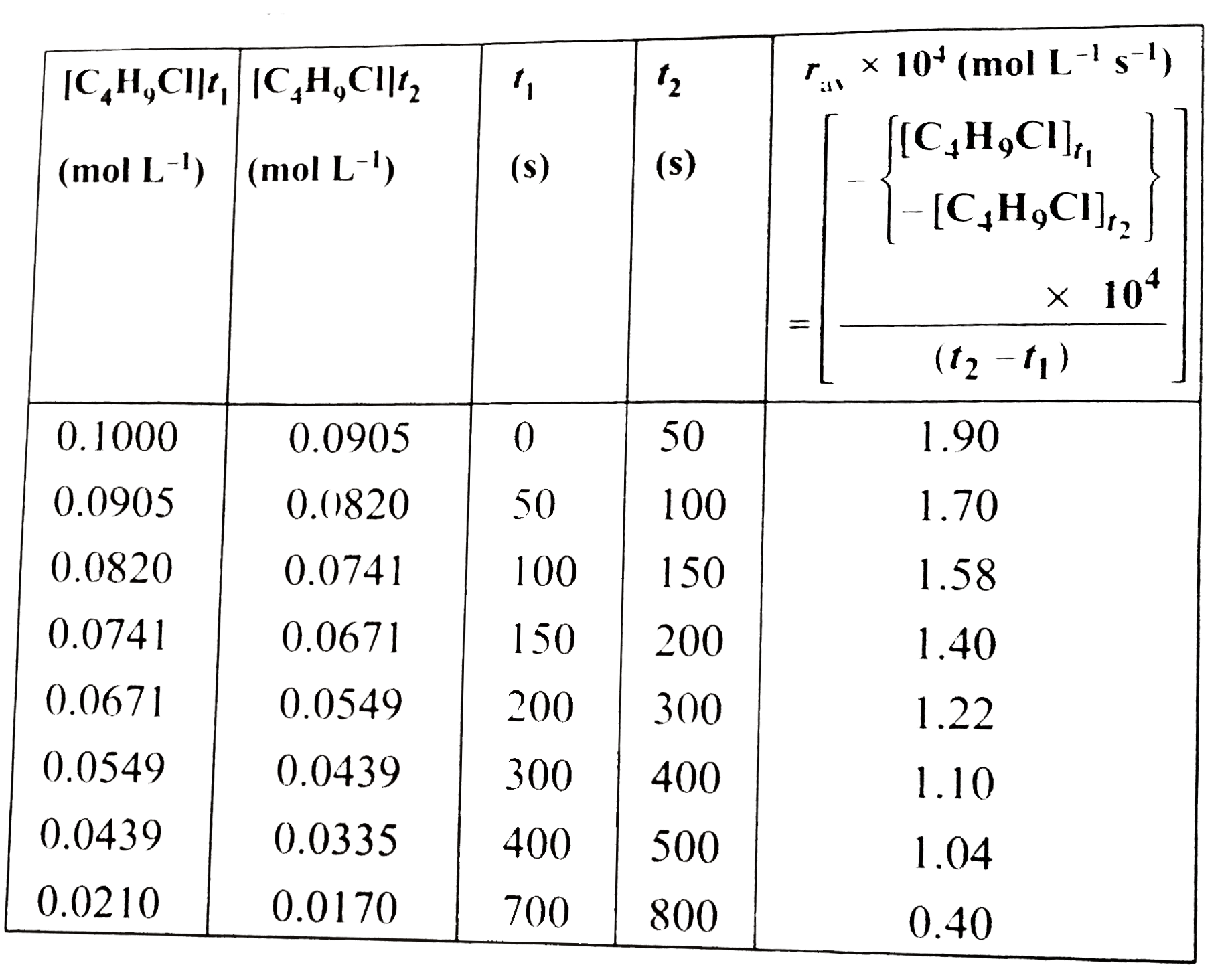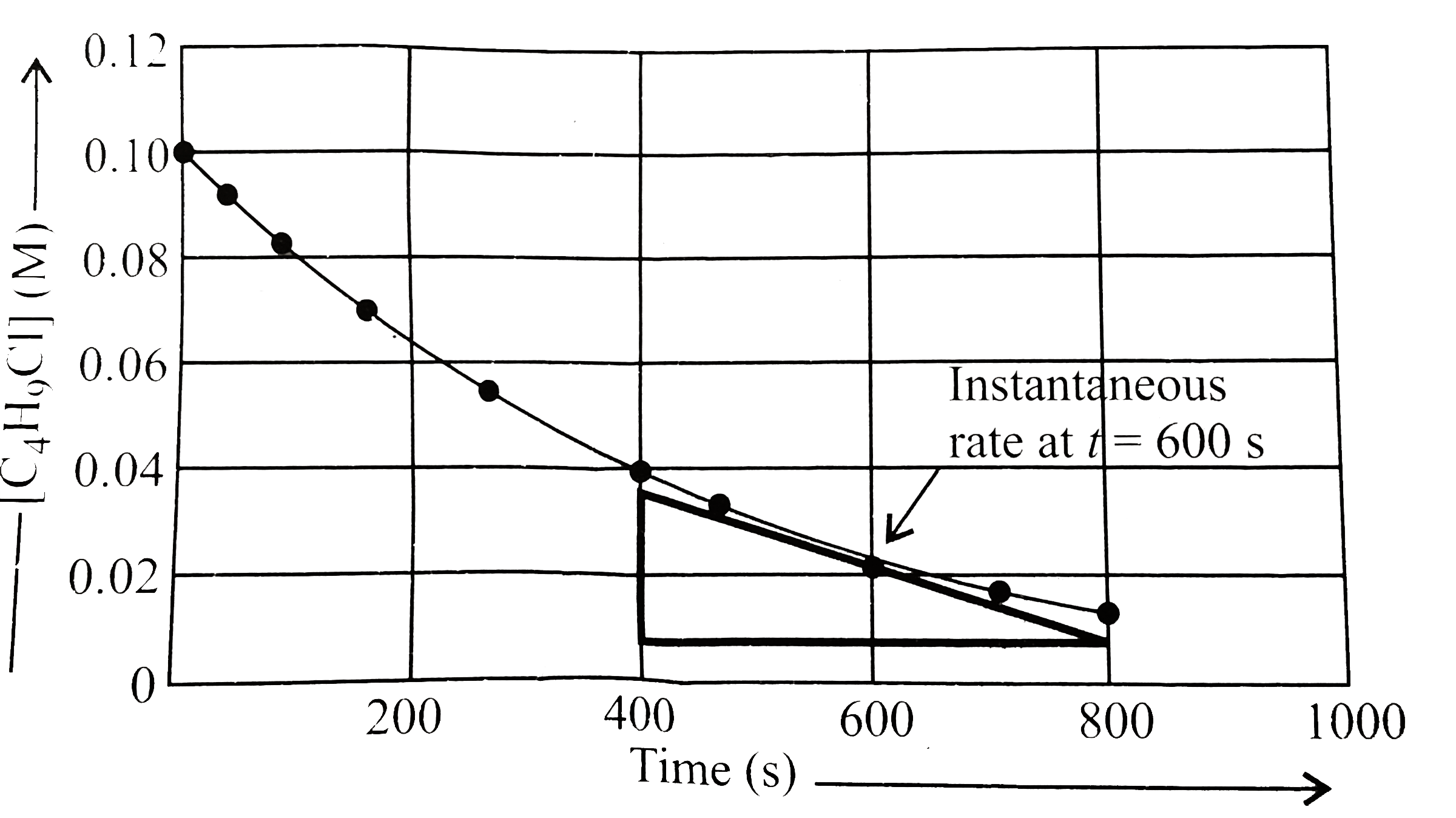From the concetration of C4H9Cl (butyl chloride) at different times given below, calculate the average rate of reaction:
C4H9Cl+H2O→C4H9OH+HCl
during different intervals of time.
∣∣
∣
∣
∣
∣
∣
∣
∣
∣
∣
∣
∣
∣∣[C4H9Cl](molL−1)t(s)0.10000.0905500.08201000.07411500.06712000.05493000.04394000.02107000.017800∣∣
∣
∣
∣
∣
∣
∣
∣
∣
∣
∣
∣
∣∣
First determine the difference in the concentration over difference intervals of time and thus determine the average rate by dividing Δ[R] by Δt.
Average rate of hydrolyiss of butyl chloride

It is clear that the average rate falls form 1.90×10−4molL−1s−1 to 0.4×10−4molL−1s−1. However, the average rate cannot be used to predict the rate of a reaction at a particular instant as it would br constant for the time interval for which it is calculated. So to express the rate at a particular moment of time, the instantaneous rate is determine. It is obtained when we conisder the average rate at the smallest time interval say dt (i.e., when Δt approaches zero). Hence, mathematically, for an infinitesmally small dt, instantaneous rate is given by:
rav=−Δ[R]Δt=Δ[P]Δt
As t→0,otrinst=−d[R]dt=d[P]dt ...(i)
It can be determined graphically by drawing a tangent at time t on either isdes of the curves for concentration of R and P vs time t calculating its slope. So in illustration 4.1, r∈st at 600s, for example, can be calculated by plotting the concentration of butyl chloride as a function of time. A tangent is drawn that touches the curve at t=600s.

The slope of this tangent gives the instantaneous rate.
So,rinst at 600s=(0.0165−0.037(800−400)s)molL−1
=5.12×10−5molL−1s−1
At t=250s,rinst=1.22×10−4,olL−1s−1
t=350s,rinst=1.0×10−4molL−1s−1
r=450s,rinst=6.4×10−5molL−1s−1
Topper's Solved these Questions
- CHEMICAL KINETICSBOOK - CENGAGE CHEMISTRYCHAPTER - CHEMICAL KINETICSEXERCISE - Solved Example
52 Videos
- CHEMICAL KINETICSBOOK - CENGAGE CHEMISTRYCHAPTER - CHEMICAL KINETICSEXERCISE - Ex 4.1 (Objective)
9 Videos
- CARBOXYLIC ACIDS AND THEIR DERIVATIVESBOOK - CENGAGE CHEMISTRYCHAPTER - CARBOXYLIC ACIDS AND THEIR DERIVATIVESEXERCISE - Exercises Archives (Analytical And Descriptive)
34 Videos
- COORDINATION COMPOUNDSBOOK - CENGAGE CHEMISTRYCHAPTER - COORDINATION COMPOUNDSEXERCISE - Archives Subjective
18 Videos
Similar Questions
Knowledge Check
For the ozonolysis of pentene in CCl4 at 300 K C5H10+O3→C5H10O3 the following data is given
[C5H10][O3]rate1.0×10−22.8×10−32.20.5×10−22.8×10−31.11.0×10−25.6×10−34.4
The over all order of reaction isA2B3C1DzeroConisder the reaction represented by the equation:
CH3Cl(g)+H2O(g)→CH3OH(g)+HCl(g)
These kinetics data were obtained for the given reaction concentrations:
Initial conc (M)Initial rate of disappearance[CH3Cl][H2O]of CH3Cl(Ms−1)0.20.210.40.220.40.48
Unit of rate constant will beAs−1BL2mol−2s−1CLmol−1s−1DmolL−1s−1
From the data given below, calculate the average rate of the reaction :
C4H9Cl+H2O→C4H9OH+HCl during different intervals of time.

View SolutionFrom the concentrations of C4H9Cl (butyl chloride) at different times given below, calculate the average rate of the reaction:
C4H9Cl+H2O→C4H9OH+HCl
during different intervals of time.
t/s050100150200300400700800[C4H9Cl]/mol−10.1000.09050.08200.07410.06710.05490.04390.02100.017
View SolutionFrom the concentrations of C4H9Cl (butyl chloride) at different times given below, calculate the average rate of the reaction:
C4H9Cl+H2O→C4H9OH+HCl
during different intervals of time.
t/s050100150200300400700800[C4H9Cl]/mol−10.1000.09050.08200.07410.06710.05490.04390.02100.017
View SolutionThe concentration of C4H9Cl (n-butyl chloride) at different times are given. Calculate the average rate for the hydrolysis of n-butyl chloride.
C4H9Cl+H2O→C4H9OH+HCl

View SolutionCH4H6ClNa/ether−−−−−→
_E01_079_Q01.png)
Write structure of C4H9Cl.
View SolutionConisder the reaction represented by the equation:
CH3Cl(g)+H2O(g)→CH3OH(g)+HCl(g)
These kinetics data were obtained for the given reaction concentrations:
Initial conc (M)Initial rate of disappearance[CH3Cl][H2O]of CH3Cl(Ms−1)0.20.210.40.220.40.48
Unit of rate constant will be
View Solution
